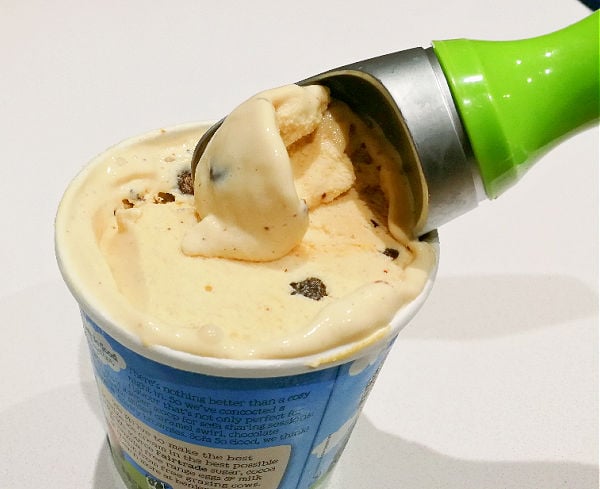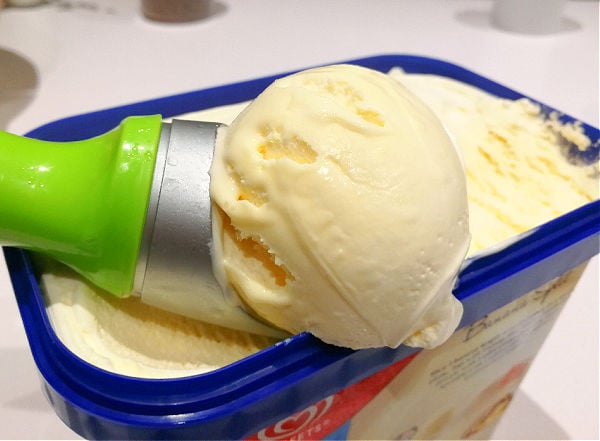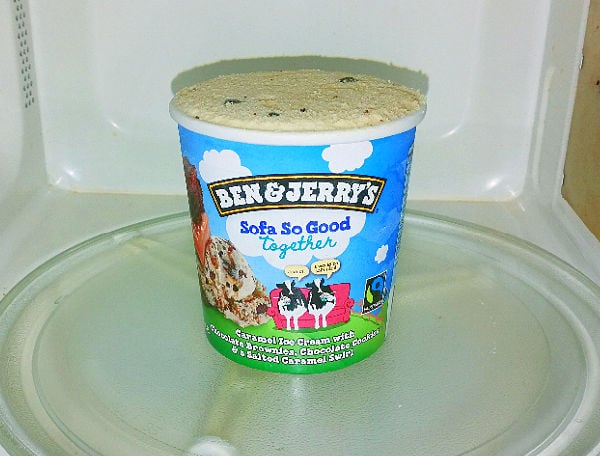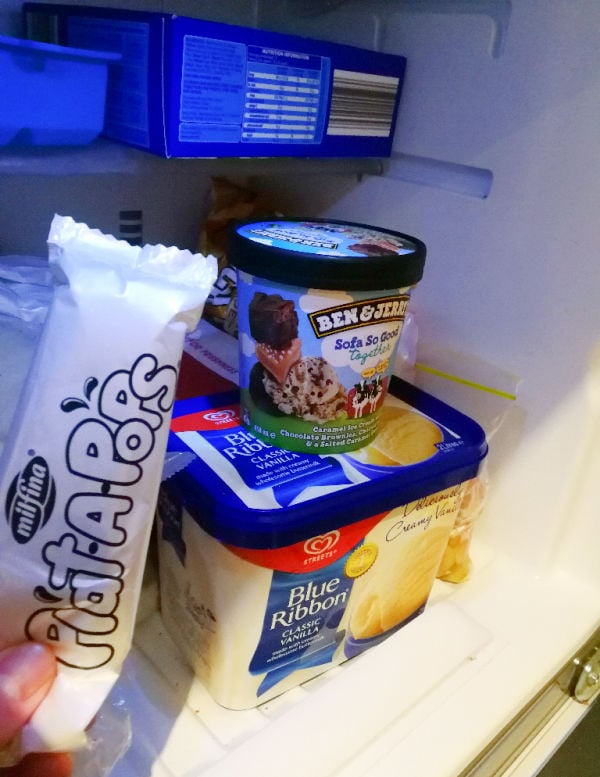Ice cream is meant to be creamy, dreamy, and easy to scoop. If you've just pulled a rock-hard pint out of the freezer, you may be wondering if microwaving is a good plan.
Our team visited everyone's favorite aisle in the grocery store and stocked up on ice cream. Next, we froze it until extra hard and tested how to soften it. Here's what we found.
Table of Contents
Can You Microwave Ice Cream?
From our testing, we found a quick way to soften ice cream was heating on medium power in 10-second bursts. The total heating time will vary depending on the microwave and quantity of ice cream; however, a 1-pint tub takes 20-30 seconds in an 800-watt microwave.
Heating a 1-pint tub
This is what to expect from a 1-pint tub of hard ice cream zapped for 30 seconds. As you can see, the outside is melted and you'll need to scoop all of that up and eat it. Re-freezing the runny stuff will result in icy ice cream.

Microwaves produce deliciously scoopable, creamy ice cream.
Heating a 2 quart tub
Here's a 2 quart (2 liter) ice cream tub microwaved for one minute on high. The texture was okay for scooping; not too soft, not too hard. Unless you're having a party and it'll all get eaten, we think other options are better than microwaving big tubs of ice cream.

Large tubs are okay microwaved but other softening methods are better.
Our conclusions
Keep in mind that ice cream doesn’t thaw evenly when microwaved. By the time the inside is smooth and scoopable, the edges will have fully melted. This led us to these conclusions:
- if you aren’t eating the whole tub in one go, then only heat it until the edges are soft; you can then scoop around the outside with great success.
- heating a whole tub will result in melted patches of ice cream. These will turn into unpleasant ice crystals if re-frozen.
- smaller pint containers are better suited to microwaving than larger, economy packs.

Ice cream is always a winner at kid's parties.
Is a microwave the best way to heat ice cream?
It’s okay to microwave ice cream if you’re in a hurry, but we don’t recommend it if you’re not going to finish the tub. The intensive, uneven heating will impact ice cream quality.
If possible, try to scoop out what you need into a microwave-safe bowl and give it a quick zap. This is a much better option than heating the whole tub.
Related reading: Take a look at our ultimate guide to making homemade ice cream.
How to microwave ice cream

Place the tub in the center of the micrwave.
If you’re in a hurry, follow these steps for softening your ice cream.
- Remove the container lid and set it aside.
- Place the tub in the center of the microwave oven.
- Heat on medium (50%) power for ten seconds then check the ice cream’s texture. If required, continue cooking in 10-second intervals until you’re satisfied.
- Remove the ice cream and immediately scoop into bowls. If there are any leftovers in the tub, quickly replace the lid and return to the freezer to avoid further melting.
Tip: If you don’t think you’ll eat all the ice cream, focus on just softening the outer area only.

You can scoop around the outside and leave the hard center for another time.
Alternative ways to soften ice cream
Refrigerator
A better method of thawing is to transfer the tub to the refrigerator. The difference between the fridge temperature and your ice cream is less extreme. Leave it for 30 minutes and the ice cream will have softened evenly, not just around the outside.
On the counter
If you can spare a little time before dessert, then sit the ice cream tub at room temperature for 10 minutes. This thawing method is a happy midpoint between refrigerating and microwaving.
In warm water
If your ice cream tub is plastic, try placing it in a sink or bowl full of warm water for 2 minutes. This should be enough time to allow the outer edges to be easily scooped.
Use a knife
A sharp kitchen knife will make easy work of slicing through ice cream. If the packaging is cardboard, you could slice the whole pack into even pieces and serve.
Scoop dipped in hot water
Experienced ice cream scoopers know that dipping the ice cream scoop in hot water makes scooping much easier. You only need to dip it in the water for a couple of seconds so it’s a quick and easy method. Try to avoid dripping water into the tub as you’ll end up with unwanted ice crystals next time.
Change the freezer temperature
Is your freezer set so cold that everything gets frozen as hard as a diamond in there? A slight adjustment should result in more scoopable ice cream next time you remove it from the freezer.

Does your freezer need to be on the coldest setting?
Is it safe to microwave ice cream?
Always check the ice cream packaging to ensure it is safe to microwave. Otherwise, the plastic could melt and potentially toxic chemicals could leach into the ice cream.
When ice cream is heated to a temperature above 41°F (5°C) it enters a danger zone where bacteria can thrive (source). Use caution when heating your ice cream and try to avoid heating and re-freezing as it increases the risk of food-borne illness.
Does microwaving ice cream cause cancer?
Microwaves heat food by causing water molecules to vibrate; studies have shown that heating ice cream (or any food) in the microwave will not cause cancer.
What can I use melted ice cream for?
Have you microwaved ice cream for too far and it’s a soggy mess? Don’t toss it out, instead, use it in milkshakes. Better yet, follow this recipe to make delicious mug cakes.
Melted ice cream mug cake recipe
Ingredients
- 1 cup melted ice cream
- ½ cup self-raising flour
Method
- Using a large mug, combine the ice cream and flour with a spoon.
- Put the mug in the center of the microwave and heat on medium-high for 2 minutes.
- Check the mug cake’s consistency and, if necessary, continue cooking in 30-second intervals until an inserted skewer removes clean.
- Serve with additional scoops of ice cream, if you have any that isn’t melted. Finally, shake over some sprinkles, melted nutella, caramel sauce, brownie chunks, and melted peanut butter for the ultimate sweet treat.
Microwave heating guide for ice cream
If you want perfect ice cream then we recommend heating 10 seconds at a time to get a perfect consistency. For a rough guide, follow the times below which worked best for an 800-watt microwave.
| Ice Cream Quantity | Heating Time |
|---|---|
| Scoop | 10 seconds |
| Pint (473ml) | 20 seconds |
| Quart (946ml) | 30 seconds |
| Gallon (3785ml) | 1 minute |

Interesting reading:
Can you microwave milk?
Are Pop Tarts good microwaved?
Will Eggos taste good cooked in a microwave?
Summing up
From a taste perspective, heating ice cream in the microwave is okay if you aren’t going to re-freeze any. Tossing leftovers back in the freezer will result in ice cream with larger ice crystals; your frozen dessert won’t retain that creamy, airy texture.
If you’re concerned about food safety, then a quick zap in the microwave is unlikely to produce food-borne bacteria. However, food that exceeds 41°F (5°C) is suitable for Listeria and other nasty bacteria to thrive. Try to avoid warming ice cream and leaving it out for any longer than necessary.
From our experience, we’ve always preferred softening hard ice cream in the fridge. Although it’s the slowest method (about 30 minutes), you’ll get evenly thawed dessert without the melted sections. For those short on time, just use a good quality ice cream scoop and dip it in hot water before use.

Leave a Reply